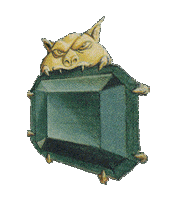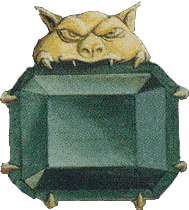
Nightmare '99 Recap
It's About Time Jerk
By Shawn
December 5, 2020
Way back in the heady days of June, we threw a pretty fun online event featuring a special Old School-ish called Nightmare '99. Set in 1999 of an alternate reality, in this world, Richard Garfield is a brutal tyrant who never admits to making mistakes, with Wizards meekly reflecting his will by never, ever issuing bannings or other errata (thus all cards are played exactly as written!). Cards through Urza Block are legal in Nightmare '99.
In this world, therefore, there are very few deckbuilding restrictions: you can play 4 of any card (yep, 4 lotuses), there are no banned cards (oh, 4 memory jar, hello), ante is used and ante cards are legal (hi 4 contract from below), and more. The only catch: you have to actually play with those cards, so if you want to play with 4 lotuses, you need access to 4 real lotuses (yes, that includes CE), with one caveat: ante is fake, so if you win a lotus in ante, you are allowed to proxy it (your opponenent meanwhile sticks it in their binder and pretends they lost it for the rest of the event). Additionally, Nightmare '99 uses the rules in effect on January 1, 1999, which was 5th Edition rules. So, there is no stack, interrupts, mana sources, and instants are all different, etc. It's degenerate, confusing, and fun.
Fast-forward 6 months or so, and my ass finally got around to writing up a summary for the event. The tournament was small, with about 20 people fielding decks, but very fun, featuring decks of a power level unmatched by any other format. As you might expect, there were a lot of turn one kills, but there were also many surprisingly interactive games. The final match between Bryan Manolakos and Randy Buehler, which you can watch on Youtube here, is a wonderful example of an actual tense, back-and-forth Magic despite the number of broken spells flying back and forth. We'd recommend trying out Nightmare '99 yourself, and go ahead and proxy if you want to (though we plan on maintaining the no-proxies rule for any official Nightmare '99 events we throw).
Below are some deck photos from the event. Our original intent was to have a "before-and-after" photo of each deck, since each deck evolved over the course of the tournament because of ante. However, we didn't get before-and-after photos for most decks, so these mostly represent the "after" states of decks from the tournament. Incidentally, cards won by ante are allowed to take you over the 4-of limit for any card, which is why some decks have things like 6 mox jets.
The Decks
Without further ado, here are some INSANE decks!

Megrim Jar (aka Broken Jar) - Randy Buehler (1st Place, 1 seed)
This deck abuses Memory Jar's symmetric draw seven coupled with EOT discarding to draw a lot of cards, eventually cast a Megrim, and then kill the opponent before they get a turn via multiple stacked up Memory Jar discards. In fact, Randy and his playtest partner Erik Lauer were the original two people who broke Memory Jar in actual 1999, prompting Wizards to issue a mid-season emergency ban on Memory Jar! Fitting that he took down the event with this deck.

Vault Key - Bryan Manolakos (2nd Place, 2 seed)
Sporting the other archetype that proved most potent in Nightmare '99, Vault Key abuses the interaction of Time Vault and Voltaic Key for infinite turns, not all that difficult to pull of on turn 1 with all the artifact mana and draw 7's. It also sports a slightly tighter combo than Megrim Jar and is less vulnerable to opposing force of wills by avoiding memory jar's symmetric draw 7 nature. But all that said, as they say, it sucks to suck.

Kaervek's Torch "Storm" - Brian Weissman (3rd-4th Place, 3 seed)
This deck plays a huge number of mana sources and card drawing engines, including recycling them with timetwister for even more mana. While not technically a storm deck, it casts a huge number of spells, generates a huge amount of mana (especially off tolarian academy), and finishes the opponent with a massive kaervek's torch, which because of its unique requirement that the opponent pay extra mana to counter it, cannot be force of will'ed unless the opponent can pay to mana, making it extremely unlikely to lose if it can go off turn 1.

Megrim Jar - Shawn Sullivan (3rd-4th Place, 4 seed)
Another entry in the powerful Megrim Jar approach, going the Dark Ritual route likely due less access to better mana sources, or the sweet Mirage art. However, note that because Mirage Dark Rituals are worded as Mana Sources, they are not able to be countered, a minor strategic advantage over some other options.

Kaervek's Torch "Storm" - Brian Limbacher (5th-8th Place, 6 seed)
A second take on the giant-kaervek's-torch-to-their-face-deck, this one uses crop rotation to chain multiple tolarian academies into massive amounts of mana. Time spiral is a nice touch too, allowing you to untap your academy for profit if you have at least 6 artifacts. The 2/2 split of force of will is a nice hedge for being on the play vs. on the draw too.

Vault Key - Stephen Hines (5th-8th Place, 7 seed Place)
This take on Vault Key sports the added insurance of main deck defensive grids and a kaervek's torch finish, not to mention a nice collection of bling. Hurkyl's recall offers a huge mana boost with all the artifact mana, plus a surprise way to bounce your own defensive grid and open up force of wills and ancestrals on your opponent's turn.

Vault Key - Quinn Maurmann (5th-8th Place, 8 seed Place)
Clocking in with some demonic consultations and yawgmoth's wills for extra boost, this Vault Key deck is yet another look. One memory jar makes for a great tinker target to keep going, and elvish spirit guides offer a sneaky way to get around defensive grids or kaervek's torch for force of will before you've had a turn.

Trick Deck - Victor Areces
How do you punish opposing decks with greedy card drawing plans? Underworld dreams of course! A great meta call, this deck includes plenty of symmetric multiple-draw spells to make sure your opponent draws themselves to death fast.

Vault Key - Ben DiMiero
With the trio of fireball, stroke of genius, and grindstone providing multiple angles of attack, this Vault Key deck has options that let it respond to different game situations when the easy turn 1 kill doesn't happen. 4 vampiric tutors go well with the 4 wheels, 3 time walks, 3 ancestrals, and stroke. Mishra's helix is interesting tech to deprive opponents of tolarian academy and other useful lands.

Teeka's Hate - Jeff Scofield
Packing multiple null rods and arcane laboratories to shut down the greedy decks, this deck aims to slow things down then drop a solid dude to attack for the win. Teeka's dragon technology provides an excellent beater that overcomes typically available chump blockers like birds.

Burn - Mox Emerald Scott
With 3 wheel of fortunes and 2 yawgmoth's wills to add to the typical Nightmare '99 contract from below and blue card draw suite, this deck aims to cast a ton of bolts and other burn to go over the top. For decks using necropotence or yawgmoth's bargain, this approach also offers a back door way to steal wins if your opponent gets to aggressive with their life total.

Vault Key - Kris Williamson
This build of Vault Key relies on countermagic and twiddle to supplement the main combo, with a sideboard full of answers to common kill conditions. Aiming to prey on non-interactive combo decks, sometimes you just need to have an extra answer or two to shut down greedy strategies.
Come Die With Us
While a few archetypes seem to be the most popular, these surprisingly diverse decks show that there is plenty of room to brew in Nightmare '99. There are enough broken cards that you simply can't cram them all into a 60-card deck, so deck design remains key to winning -- the winning deck included less power than many of the other decks, for example. And of course, key to the format, who doesn't want to cast contract from below.
Nightmare '99 is pure, degenerate carnage. Enjoy the terror!

